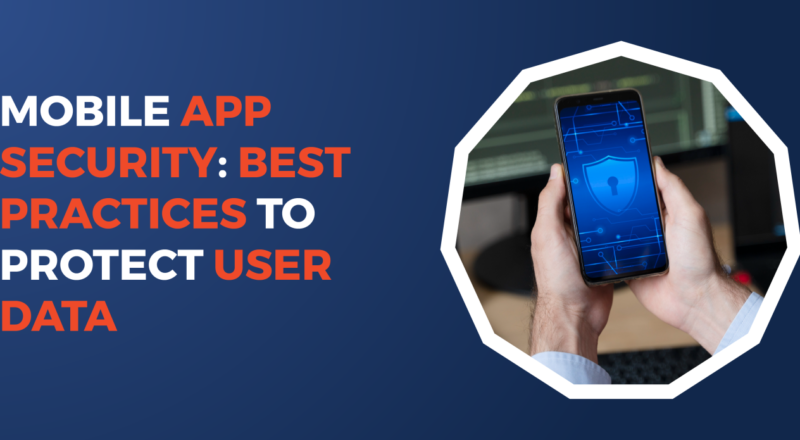In the current digital environment, user data security in mobile apps has become a crucial problem. Data security management has become a major concern for companies and app developers due to the increase in the use of mobile apps. Regrettably, as hackers discover new techniques to take advantage of weaknesses in mobile apps, the threats associated with app security are also growing. Best practices for mobile app security attempt to close any gaps in the coding that hackers could discover and perform frequent updates. Continue reading to find out the best security measures that developers can do to minimise security issues and protect their mobile apps from security breaches.
Why is Mobile Security Important?
- Since mobile applications are the main means of communication between consumers and businesses, they need a safe environment to store sensitive user data.
- Inadequate security measures can result in data breaches, which expose private user information to possible dangers.
- Better data protection is required due to mounting regulatory pressure, and noncompliance may result in severe penalties.
- Strong security procedures help to establish and preserve user confidence.
- An organization’s reputation might be harmed and client loyalty can be decreased by using inadequate security measures.
- Having strong security measures might provide an advantage in the app store.
- High security is necessary for technological breakthroughs like Internet of Things apps to operate reliably.
The Best Methods for Securing Mobile Apps
Using mobile app security best practices, it’s critical to include the finest security features to preserve mobile apps and user data from various attacks.
The following are some of the mobile app security checklist’s best practices:
Encryption of data
Sensitive data is protected when encryption methods are used. Additionally, this data is used as stored data on the device for network transmission. Users may ensure that even in the unlikely event that hackers have unauthorised access to their data, they will be unable to decrypt it without the encryption key by using data encryption.
Enforcing Security Policies Consistently
Proactively safeguarding mobile applications aids in the mitigation of several risks that frequently impact them. Enforcers of mobile application management rules make ensuring that measures like access restrictions, encryption, authentication, and data loss prevention are implemented. This aids in protecting the mobile application and devices from a range of security risks, including virus assaults, data breaches, unauthorised access, rooting or jailbreaking, insecure third-party components, and authentication issues.
Fortify Authentication Systems
Put in place reliable procedures for user authentication. Your app’s security may be improved by using a mix of password, username, and secondary verification methods like biometric authentication or OTPs. Use multi-factor authentication (MFA), for instance, which forces users to authenticate with two or more separate credentials.
Apply updates and patches regularly
Frequently provide fixes and updates to address vulnerabilities found. Updating your app lowers the possibility of security lapses. As an illustration, set up a mechanism for routine app updates and apply patches as soon as a security flaw is found.
Track and Address Threats Instantaneously
Put in place systems that can continuously monitor your application and identify potential risks. Use iOS mobile app security best practices to maximise security by acting quickly on any vulnerabilities found. Make use of threat detection tools to spot questionable activities and notify your staff right away. Create an incident response strategy so you can take prompt action when hazards are detected.
Identification of Tampering
This feature aids in alerting developers or application owners when there is an attempt by an unauthorised party to alter or compromise data on a device or the device itself. It is useful in implementing the required preventative actions to address the issue at the appropriate moment and either eliminate or lessen its impact. Tampering with mobile app security refers to changing the app’s compiled code, operating process, or environment. Identifying tampering attempts aids in ensuring that no unauthorised individuals have recompiled a programme without the owner’s knowledge before it was released.
Examine incidents in-depth
It is crucial to conduct a comprehensive investigation into each security incident that takes place in order to determine what caused it and how to stop it from happening again. Assign incident analysis to a specialised team. Make sure to document any relevant information regarding the event, such as the time it happened, its effects, and the steps taken to resolve it.
Put Binary Protection Into Practice
These are a series of steps that stop malicious actors from manipulating programmes and make it much harder for them to change the code or how they work. Appropriate techniques and tools are applied as an additional safeguard to prevent reverse engineering from being used to exploit binary files.
Read: What Is The Login Canvas Fisd And How To Login On To It?
Typical Dangers to Mobile App Security
Best practices for protecting mobile apps are frequently compromised by a number of dangers, including:
Attachments containing malware
Malware may infect mobile applications through insecure third-party integrations, endangering their security and functionality.
Information Exposure
Inadvertent data exposure might result from unsafe communication routes or poor data preservation.
Regular API Dangers
When unprotected APIs are used often, fraudsters can take advantage of application weaknesses.
Unsecured Network Communications
Since information sent across insecure networks can be intercepted and modified, using them for app communication might lead to data breaches.
Phishing Attempts
fraudulent attempts to pose as reliable entities in an internet connection in order to gain sensitive information.
Conclusion
As more people use smartphones, mobile application security becomes increasingly important. Nonetheless, this implies a heightened potential for deception and cyberattacks. Security precautions in mobile apps must thus be given top priority by users, developers, and organisations.
The following rules and constantly changing security measures have also been suggested. Thus, in the field of mobile application development, developers may produce apps that offer a secure and safe user experience.
